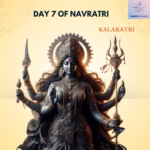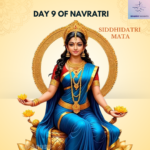Navratri is a vibrant festival. It’s a nine-day celebration that reverberates with devotion, dance, and music.
The festival is dedicated to Goddess Durga. She is revered in her nine forms over these nine nights.
The 8th day of Navratri holds a special significance. Known as Ashtami, it’s a day of great importance in the festival.
On this day, devotees worship Maa Mahagauri. She is the eighth avatar of Goddess Durga.
Mahagauri symbolizes purity and tranquility. She is also a beacon of peace and wisdom.
The color associated with this day is pink. It signifies hope and a fresh start.
Devotees observe fasts and perform special pujas. They sing the 8th day of Navratri aarti, a devotional song in praise of Maa Mahagauri.
Specific mantras are chanted. These mantras invoke the blessings of Mahagauri.
In many parts of India, this day is also celebrated as Durga Ashtami. It’s a day filled with fervor and grandeur.
Young girls are worshipped in a ritual known as Kanya Puja. They are seen as embodiments of the goddess herself.
The story of Mahagauri’s origin is narrated. Her significance in Hindu mythology is discussed during the festival.
Cultural events are organized. Dance performances and music recitals add to the festive spirit.
Traditional dances like Garba and Dandiya are performed. These dances are integral to Navratri events.
The 8th day of Navratri is considered auspicious for new beginnings. Many choose this day to start new ventures.
Devotees dress in traditional attire. They visit temples to offer prayers and seek blessings.
This day is not just about rituals and traditions. It’s also about community, unity, and celebration.
Join us as we delve deeper into the significance of the 8th day of Navratri. We’ll explore the rituals, the celebrations, and the goddess who is worshipped on this day.
Let’s celebrate the 8th day of Navratri together. Let’s embrace the spirit of this vibrant festival.
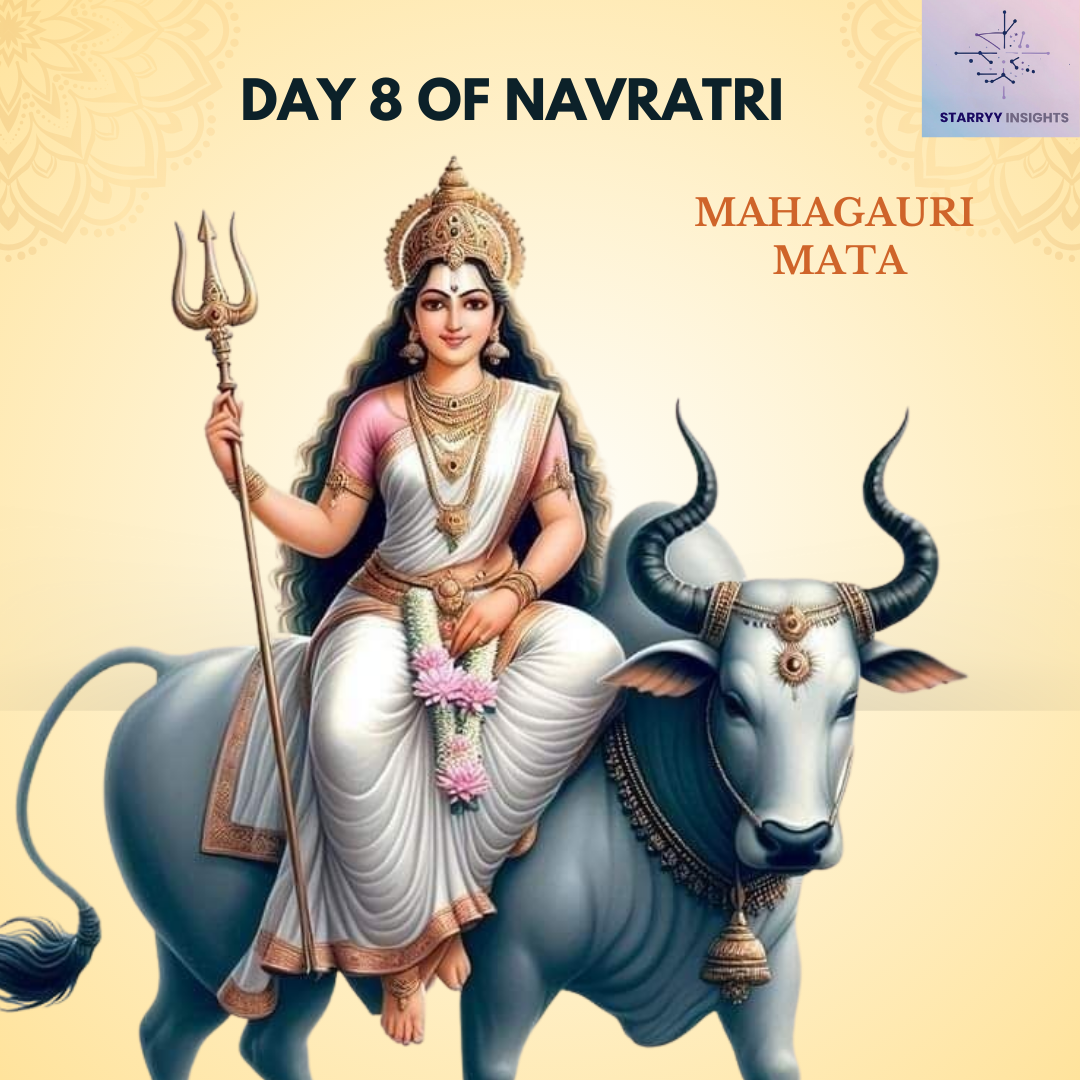
The Essence of Navratri and the 8th Day Significance
Navratri is more than a festival; it’s a spiritual journey. This Hindu celebration honors the nine forms of the powerful Goddess Durga. Spanning nine nights, each day is devoted to a different form of the goddess, each representing distinct qualities and virtues.
The name Navratri itself, derived from the Sanskrit words ‘Nav’ (nine) and ‘Ratri’ (night), signifies the festival’s duration. These nights are filled with pujas, fasting, prayers, and cultural activities. Devotees devote themselves to introspection and devotion, aiming for spiritual growth.
Navratri symbolizes the triumph of good over evil. It reenacts the historical victory of Goddess Durga over the demon Mahishasura. This underscores the essence of Navratri as a period of renewal and moral cleansing.
The celebration has deep-rooted cultural and religious significance. Each region in India adds its unique flavor and customs, making it a multifaceted festival. The diversity in celebrations showcases India’s rich heritage.
Among these nine divine days, the 8th day, known as Ashtami, holds special importance. The day celebrates the eighth form of the divine feminine power: Mahagauri.
On Ashtami, unique rituals and cultural events are organized, marking a climax of devotion and celebration. Let’s delve deeper to understand Navratri’s rich tapestry and Ashtami’s pivotal role in it.
Understanding Navratri and Its Nine Nights
Navratri is a melange of devotional and cultural expressions. The nine nights celebrate different aspects of feminine divinity, with devotees engaging in dance, music, and ritual worship.
The festival begins with a prayer to Shailaputri, the goddess of mountains. She embodies strength and resolve. The following nights successively honor Brahmacharini, Chandraghanta, Kushmanda, Skandamata, Katyayani, Kalaratri, and Mahagauri, culminating with Siddhidatri.
Each form symbolizes attributes that devotees aspire to emulate. From wisdom and discipline to peace and prosperity, the festival covers a spectrum of life’s moral and spiritual ideals.
The prayers and mantras recited each day play a crucial role. They focus the mind and create a holy atmosphere, encouraging spiritual growth and introspection.
Apart from religious significance, Navratri is also a time for social interaction. Community events, traditional dance forms like Garba and Dandiya, and cultural gatherings foster communal harmony and joy.
The rituals have evolved over time. Yet, the essence remains the celebration of the victory of good over evil. Each region interprets and celebrates the festival in its own way, contributing to its rich diversity.
The Special Role of the 8th Day: Ashtami
The 8th day of Navratri, Ashtami, is dedicated to Mahagauri. She is the symbol of purity, peace, and compassion. Her complexion is described as radiant, like the moon, conveying tranquility.
Ashtami is significant for many reasons. It’s seen as a day of hope and divine grace. Devotees gather at temples to perform special prayers and rituals for blessings.
Fasting is a common practice on this day. It serves as a means of purification, aligning both body and mind towards spiritual goals.
The evening of Ashtami is often marked by Kanya Puja. In this ritual, young girls, representing the divine feminine, are worshipped. They are honored with gifts and traditional foods, signifying reverence and gratitude.
In addition to these rituals, the 8th day fosters a vibrant cultural atmosphere. Music and dance events are organized, adding a layer of joy to the spiritual fervor.
Ashtami acts as a crescendo in the Navratri festival. It prepares devotees for the grand culmination of Navratri, acknowledging both the divine and the human in its festivities.
Goddess Mahagauri: The Deity of the 8th Day
Mahagauri, the revered goddess of the 8th day of Navratri, embodies purity. She is one of the nine manifestations of Goddess Durga, who is worshipped for her serenity and purifying energy.
Mahagauri is often depicted riding a white bull and holding a trident and drum. Her imagery is soothing, intended to inspire peace and benevolence. Her presence symbolizes the cleansing of sins and the renewal of one’s soul.
The worship of Mahagauri holds deep spiritual significance for devotees. It is believed her blessings bring peace and prosperity, making this day significant for seeking forgiveness and rejuvenation.
Wearing the color pink on this day is a common practice. Pink signifies hope and a fresh start, reflecting the purity and compassion associated with Mahagauri. It is a visual celebration of the day’s spirit.
The rituals performed in her honor are meticulous. Devotees follow specific rituals, often fasting in her name, to draw closer to her divine grace. The aim is to evoke her qualities within themselves.
Who is Maa Mahagauri?
Maa Mahagauri, known for her fair complexion, is the epitome of purity. Her name, translating to “extremely white,” signifies her unblemished, radiant beauty. She is considered an embodiment of peace and tranquility.
Her divine form is particularly worshipped by those seeking to eliminate flaws and impurities from their lives. Mahagauri’s devotees aspire to emulate her serenity and tranquility in their personal and spiritual lives.
Mahagauri’s four arms carry specific symbolic items—a trident and a drum in two, while the other two are in gestures of blessing and fearlessness. These represent her abilities to bless, protect, and guide.
Her serene image appeals to the hearts of her followers. By invoking her presence, they hope to bring clarity and calm into their chaotic lives. Her gentle smile inspires love and compassion, spreading harmony.
The qualities that Mahagauri embodies are not only aspirational but also perceived as a direct pathway to spiritual upliftment. Her worship is a call to internalize these divine virtues.
Legends and Stories of Mahagauri
The legend of Mahagauri is entwined with devotion and penance. As the story goes, Parvati, in a bid to unite with Lord Shiva, undertook a harsh regimen of penance. Her dedication transformed her into Mahagauri.
The intensity of her penance was such that it turned her complexion dark. It was only through divine grace that her original, fair appearance was restored, marking her purity and spiritual triumph.
Her transformation is symbolic. It highlights the victory of enduring faith and commitment to spiritual endeavors, exemplifying the power of devotion and perseverance in overcoming the darkness.
Mahagauri’s story resonates with those navigating their spiritual journeys. It underscores a fundamental belief that true devotion can cleanse the soul, removing all impurities accumulated from worldly life.
Her legend also emphasizes divine love. Mahagauri’s penance was motivated by deep love for Lord Shiva, teaching devotees the power of love in guiding one’s spiritual path and achieving union with the divine.
Rituals and Celebrations on Navratri Day 8
The 8th day of Navratri, also known as Ashtami, is filled with reverence and joy. It is one of the most important days during Navratri, celebrating the worship of Goddess Mahagauri. The day is marked by a series of rituals and festivities, each symbolizing spiritual devotion and communal harmony.
Fasting and pujas are central to the day’s observance. Devotees engage deeply with these practices, aiming to purify their bodies and minds. Fasting is both a spiritual and physical discipline that enhances focus and devotion.
Apart from spiritual practices, the day is enlivened with cultural events. Communities come together, participating in music, dance, and other social gatherings. This reflects Navratri’s nature as a festival that celebrates both spirituality and culture.
Fasting and Puja Rituals
Fasting on the 8th day of Navratri holds profound spiritual significance. It is an act of devotion, symbolizing the devotee’s commitment to purity and discipline. Many undertake this fast to seek the blessings of Maa Mahagauri.
Fasting is often observed in several ways:
- Nirjala Fast: Abstaining from both food and water.
- Phalahar Fast: Consuming only fruits and milk.
- Partial Fast: Eating only one meal in the afternoon or evening.
Each type of fasting comes with its own level of sacrifice and dedication. It is believed that such austerity helps cleanse the soul, leaving one more receptive to divine blessings.
The puja rituals performed on this day are equally significant. Devotees begin with a ritual bath, signifying purification. They then create a sacred space for worship with decorations and offerings.
The puja includes lighting of a diya, offering flowers, and chanting mantras dedicated to Mahagauri. Incense and sandalwood are also used to create a sanctified atmosphere. Aarti is performed with devotion, praying for protection and peace.
Young girls, representing the goddess, are often invited for Kanya Puja. This ritual involves offering food and gifts to the girls, acknowledging their divine aspect.
These practices connect participants with the spiritual essence of Navratri. They also provide an opportunity to express gratitude and seek divine guidance for the future.
Cultural Events and Social Gatherings
Navratri’s 8th day is not just about quiet devotion. It is also marked by vibrant cultural celebrations. Communities across India organize events that foster togetherness and joy.
Dance and music are central to these celebrations. Traditional forms like Garba and Dandiya are enthusiastically performed. These dances are social activities, with participants forming circles and moving in rhythmic patterns.
A variety of music, from traditional hymns to contemporary tunes, sets the tone for the evening. The diversity in styles reflects the festival’s universal appeal, embracing change while preserving tradition.
Besides dance and music, the day is filled with other social gatherings. Neighborhoods and communities host feasts, fostering a sense of unity. Special navratri-themed games and competitions add to the excitement.
Here are some popular Navratri events seen during this time:
- Dandiya Night: A spirited evening of dance and rhythm.
- Cultural Shows: Performances displaying local talents and traditions.
- Food Festivals: Celebration of traditional and festive cuisines.
Social media plays a significant role in these events, connecting people across distances. It amplifies invitations and shares moments of joy and togetherness.
These gatherings highlight Navratri’s role in promoting community and friendship. As people share in the festivities, bonds are strengthened and joy is multiplied.
The 8th Day of Navratri Aarti and Mantras
The spiritual core of the 8th day of Navratri is enriched by the aarti and the chanting of sacred mantras. These practices provide a sublime medium through which devotees connect with Maa Mahagauri. Aarti, an offering of light, and mantras, sacred chants, are integral to seeking the goddess’s blessings.
The Significance of Aarti in Worship
Aarti holds a profound place in Hindu worship. It is more than a ritual; it’s a heartfelt prayer through light and song. On the 8th day, the aarti is dedicated to Maa Mahagauri. The warmth of the flame signifies the dispelling of darkness and ignorance. This act is both symbolic and literal, illuminating the divine presence in the devotee’s life.
The aarti is often performed with specific songs or bhajans. These devotional tunes celebrate the grace and power of the goddess. As the flame is circled before the deity, devotees sing together, enhancing the spiritual atmosphere. This shared prayer fosters a deep sense of community and belonging.
Aarti involves certain key elements: a lit diya (lamp), incense, and sometimes, conch shells. These components create a multisensory experience. The light, scent, and sound come together to invoke divine energy. Each aspect is meticulously chosen to heighten the connection with the goddess.
The aarti is concluded by moving the flame towards the devotees. This act is a symbolic blessing, with the light purifying and sanctifying their existence. It signifies receiving the goddess’s grace and protection.
Moreover, the act of taking aarti blessings from the flame is a moment of personal reflection. It allows devotees to internalize the divine light, offering a moment of introspection and prayer. This tradition is timeless, passed down through generations with unwavering reverence.
Aarti serves as a powerful emotional anchor. In moments of despair or uncertainty, this practice is a reminder of divine guidance and support. It transcends the physical realm, offering solace and hope to the believer.
Mantras and Their Meanings
Mantras possess a unique power in Hindu rituals. These sacred syllables are vibrations that unite the mind and soul with divine consciousness. On the 8th day of Navratri, specific mantras honor Goddess Mahagauri’s purity and grace.
Chanting begins with an invocation, “Om Devi Mahagauryai Namah.” This mantra pays respect and seeks the goddess’s blessings. The repetition instills peace and focus, drawing devotees closer to the divine presence.
The meanings behind these mantras are profound. Each word carries energy designed to elevate spiritual awareness. They are often chanted with closed eyes, allowing inward focus. This introspection facilitates a connection with the higher self and the divine.
Chanting mantras is believed to offer numerous benefits. They cleanse the mind and purify one’s aura. The rhythmic sound fosters calmness and concentration. Regular chanting imbues life with positivity and balance.
Mantras also play a pivotal role in meditation. When recited with devotion, they serve as a bridge to deeper states of consciousness. This practice is a journey inward, exploring spiritual dimensions beyond the mundane.
The efficacy of mantras lies in their phonetic resonance. Ancient sages understood the power of sound. The vibration created by chanting syncs with universal energies. This attunement aligns the chanter with cosmic harmony.
During Navratri, mantra chanting peaks in importance. It holds the capacity to transform negative energies into spiritual strength. Moreover, for many, it becomes a meditative practice, promoting inner peace and equanimity.
Ultimately, mantras are more than words. They are sacred links to divine wisdom. Through constant practice, devotees find solace and strength within them. On the auspicious 8th day, these chants echo the profound devotion to Maa Mahagauri.
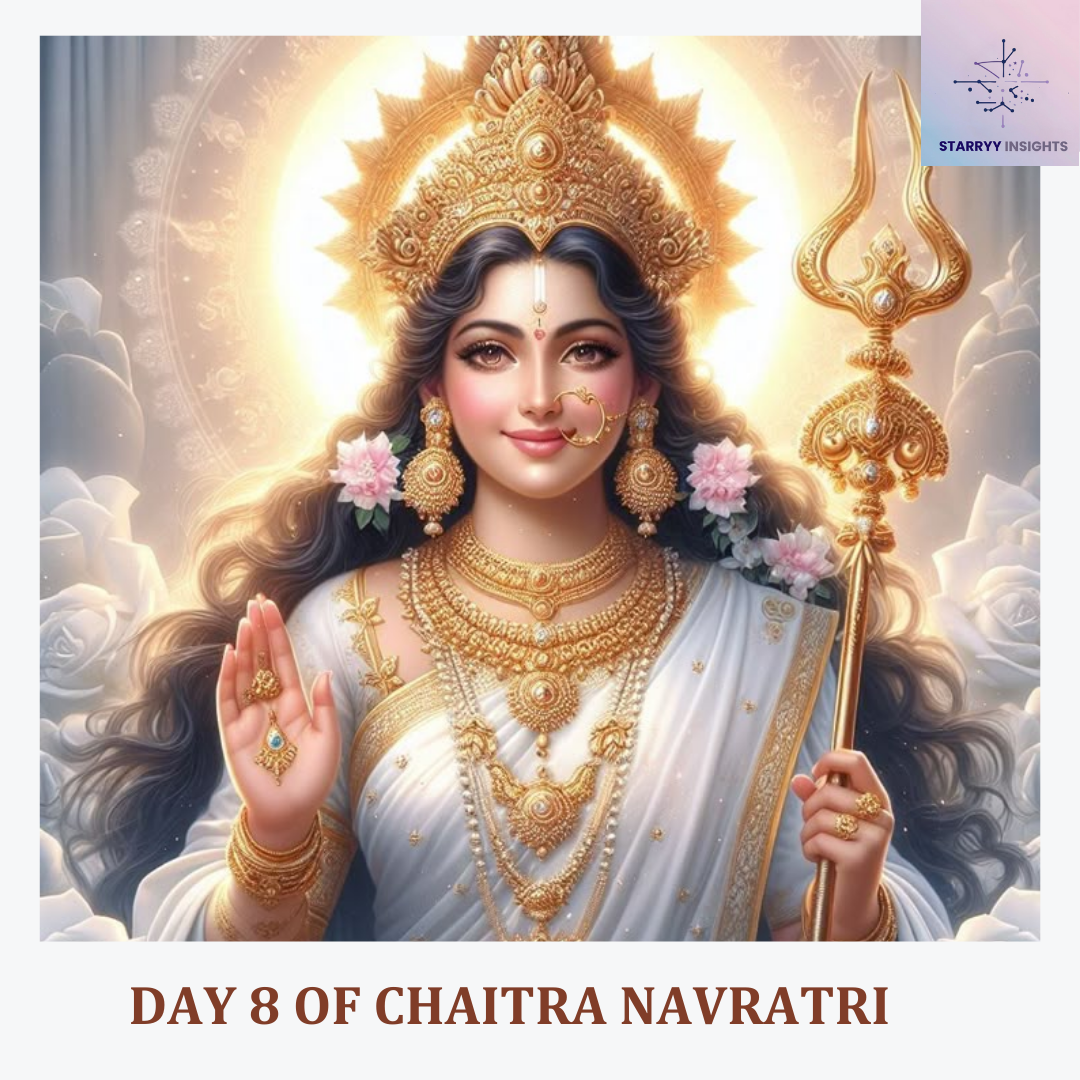
Regional Variations in Celebrating the 8th Day of Navratri
The 8th day of Navratri, known as Ashtami, is celebrated with diverse traditions across India. Each region brings its own cultural essence to the rituals and festivities, reflecting a rich tapestry of beliefs and practices. This diversity highlights not only regional differences but also a shared devotion to Goddess Durga.
In northern parts of India, Kanya Puja is a prominent ceremony. Young girls, representing the nine forms of Durga, are invited to homes and are offered special meals. This practice honors the feminine divine and blesses families with purity and prosperity.
Meanwhile, the western states, like Gujarat, host grand Navratri events featuring Garba and Dandiya. These traditional dances invite community participation, creating lively and vibrant celebrations. Devotees dress in colorful attire, enhancing the festive spirit.
In eastern India, particularly in West Bengal, Durga Puja reaches its zenith. The 8th day, known as Mahashtami, witnesses elaborate pujas and cultural programs. The streets are adorned with ornate decorations, and the air is filled with devotional songs.
Southern India, too, has its unique ways of observing Navratri Day 8. In Tamil Nadu and Karnataka, families display Golu, an arrangement of dolls representing the divine hierarchy. This artistic display is both a spiritual and educational endeavor, engaging the entire community.
Here is a snapshot of regional variations:
- North India: Kanya Puja is central; girls are revered.
- West India: Traditional dances enliven the celebrations.
- East India: Durga Puja is a grand spectacle.
- South India: Golu display marks the devotion.
Durga Ashtami in Different Parts of India
Durga Ashtami holds special significance across India, celebrated with distinct customs and fervor. In Haryana, Punjab, and Uttar Pradesh, it is customary to conduct rituals of fasting and worship. Special offerings are made to the goddess, focusing on purification and commitment.
In Bihar and Jharkhand, communal gatherings for Durga aarti are prevalent. Temples conduct large-scale worship services, drawing devotees from all walks of life. These regions emphasize community participation, often leading to large public feasts or “Bhandaras.”
In Madhya Pradesh, the day is associated with fasting and worship. Families come together in prayer, chanting mantras dedicated to Mahagauri. The cultural essence here is marked by simplicity and devotion, reflecting the core spiritual values of Navratri.
The coastal areas of Odisha also celebrate Durga Ashtami with reverence. Here, the focus is on intricate rituals and processions. Devotees engage in traditional practices, maintaining a connection with age-old customs passed down through generations.
In Rajasthan, Navratri involves unique offerings to the goddess. The 8th day sees families performing special prayers at home. They also prepare “khichdi,” a savory dish, as a part of their ritual fasting menu, underscoring the day’s sanctity.
Global Celebrations of Navratri Day 8
Beyond India’s borders, the 8th day of Navratri is celebrated by the Indian diaspora globally. Each community brings elements of its native customs, mixing them with local traditions to honor Maa Mahagauri.
In the United States, Navratri celebrations are especially pronounced in cities with significant Indian populations. Cultural associations arrange dance evenings, where people of all ages participate in Garba and Dandiya. These events promote cultural exchange and unity.
In the United Kingdom, temples organize elaborate Durga Puja ceremonies. Devotees gather to witness aarti and performances, enjoying a sense of community. These gatherings often extend beyond spiritual practices, including cultural activities such as food festivals and bazaars.
In countries like Singapore and Malaysia, Navratri is an occasion of cultural pride. Indian communities showcase traditional music and dance forms, drawing participation from diverse backgrounds. This creates an inclusive atmosphere where cultural appreciation thrives.
Australia sees vibrant Navratri events too. Local Indian organizations host religious ceremonies followed by community dinners. Such events help maintain cultural ties, offering a taste of home away from home.
Lastly, in Canada, Navratri highlights the inclusivity of Indian traditions. Here, the 8th day features community-centric activities. People come together not only for worship but also for learning and sharing, fostering harmony among different cultures.
The Culinary Delights of Navratri
Navratri is not only a spiritual journey but also a gastronomic celebration. Fasting during Navratri doesn’t mean you have to compromise on taste. On the contrary, it introduces a rich variety of foods and recipes that are both delicious and healthy.
Fasting foods, or “vrat ka khana,” adhere to specific dietary restrictions. However, they still offer a wide array of flavors. Ingredients like buckwheat flour, water chestnut flour, and millets become the stars of the Navratri menu.
Rich in fiber and nutrients, these ingredients are used to prepare fasting snacks and meals. Devotees creatively use them in dishes like sabudana khichdi, kuttu ki puri, and vrat ke aloo. These foods help maintain energy levels throughout the fasting period.
The culinary creativity during Navratri is endless. Cooks experiment with spices that are allowed during fasting. Cumin, rock salt, and green chili add flavor to fasting recipes without overwhelming the natural taste of the ingredients.
Fasting Foods and Recipes
Fasting during Navratri allows devotees to explore unique dishes that are traditionally enjoyed during this period. Sabudana khichdi is a popular choice, made with sago pearls, peanuts, and potatoes. It’s light yet satisfying, providing enough energy for the day.
Kuttu ki puri, made from buckwheat flour, is often paired with aloo sabzi. This combination is a staple in many households observing Navratri fasting. Kuttu provides the necessary carbohydrates, while the potatoes offer filling comfort.
Singhare ke atte ka halwa adds a touch of sweetness. This dessert, made from water chestnut flour, is enriched with ghee and dry fruits. It offers a delightful treat to those observing fasts.
Another favored dish is rajgira paratha. Amaranth flour is used to make these flatbreads, which are high in protein and iron. These parathas pair well with cucumber raita, providing a refreshing contrast.
The Significance of Navratri Feasts
Navratri feasts, though seemingly simple, carry profound significance. They offer a time for families to gather and share not just meals but also their Navratri experiences. The act of preparing and enjoying these meals reinforces bonds and traditions.
The ingredients used in these meals are chosen not just for their fasting compliance but also for their health benefits. They are meant to cleanse and rejuvenate the body. This aligns with the festival’s spiritual goals of purification and renewal.
Navratri dishes are balanced, ensuring that those fasting receive adequate nutrition. This includes proteins from nuts and dairy, carbohydrates from millets, and essential fats from ghee and oils. These meals maintain the body’s equilibrium during the fasting period.
In essence, the culinary delights of Navratri echo the festival’s theme of devotion and transformation. They demonstrate that fasting is not simply about abstaining but embracing wholesome living. The feasts represent community spirit and cultural pride, integral to Navratri’s joyous celebrations.
Fashion, Music, and Dance: The Vibrancy of Navratri
Navratri is a festival of colors, rhythms, and elegance. Every aspect, from attire to dance, adds to its vibrancy. This celebration of nine nights offers a feast for the senses, blending tradition with modernity.
Fashion, music, and dance elevate the festive spirit. They reflect cultural richness and diversity. As Navratri unfolds, each of these elements comes alive, creating an atmosphere of joyful celebration.
Traditional Attires and Trends
Fashion during Navratri is an expression of tradition and style. Men and women adorn themselves in traditional garments that are both colorful and intricate. For women, vibrant ghagra cholis embellished with mirrors and embroidery are popular. These ensembles are paired with bold jewelry that complements the festive attire.
Men often wear kurtas and dhotis or pajama sets in rich colors and patterns. Fabrics like silk and cotton add comfort and elegance. The attire is not merely for show; it connects the wearer to cultural roots and heritage.
Navratri fashion trends evolve, incorporating contemporary elements. While traditional costumes remain at the core, modern styles and cuts give them a fresh perspective. This blend allows individuals to express their unique sense of style while honoring tradition.
Fashion during Navratri also involves the use of colors. Each day is associated with a specific color, believed to bring good fortune. These colors add to the thematic depth of the festivities, enhancing their visual impact.
Navratri Music and Dance Forms
Music and dance are integral to Navratri, bringing communities together. Garba and Dandiya Raas are the signature dance forms performed during this festival. These dances are filled with energy and rhythm, captivating participants and spectators alike.
Garba is usually performed in circles, symbolizing the cycle of time and life. Dancers move gracefully, clapping their hands in sync with the beat. The circular formation creates a dynamic spectacle, illustrating unity and continuity.
Dandiya Raas, performed with sticks, is spirited and lively. The sticks represent swords, paying homage to Goddess Durga’s battles against evil. Dance steps are precise, and the clattering sticks add a musical layer, enhancing the experience.
Traditional bhajans and modern renditions keep pace with the dancers. The music is a harmonious blend, bridging traditional and contemporary sounds. It serves as a backdrop for the dances, elevating the festive mood.
The Role of Social Media in Navratri Celebrations
Social media has transformed how Navratri is celebrated and shared. Platforms like Instagram and Facebook abound with photos and videos of events. People showcase their outfits, dances, and devotion, making the festival a global spectacle.
Social media helps spread information and raise awareness. Organizers use these platforms to promote events, drawing crowds to public celebrations. People connect, sharing their experiences and learning from diverse cultural practices.
Fashion influencers and bloggers play a significant role, offering style inspiration. They showcase Navratri fashion trends, suggesting ways to blend traditional and modern attire. Tutorials on makeup and accessorizing have also become popular, guiding individuals to look their best.
Music and dance tutorials on social media allow people to learn from home. Online sessions teach steps and routines, helping enthusiasts participate. This ease of access makes Navratri inclusive, drawing in new generations eager to be part of the festivity.
Spiritual and Social Dimensions of the 8th Day of Navratri
The 8th day of Navratri, known as Ashtami, carries profound spiritual significance. This day is dedicated to worshiping Maa Mahagauri, who is believed to bring purity and tranquility to her devotees. The atmosphere is charged with devotion and reverence, as individuals and communities come together to celebrate this sacred occasion.
Spiritual practices take center stage on this day. Devotees engage in rituals and meditation, seeking blessings for prosperity and happiness. Cultural and social gatherings reflect a sense of unity and shared purpose. The day serves as a reminder of the importance of community bonds and mutual support.
Charity plays a crucial role, with many people giving freely to those in need. Altruistic acts are seen as a way to emulate the goddess’s virtues. This day also shines a light on the collective effort to create a more compassionate and harmonious world.
Charity, Community, and Unity
Charity on the 8th day of Navratri holds special importance. It is a time when people are encouraged to extend help to the less fortunate. This giving nature is closely tied to the teachings of Maa Mahagauri, who embodies compassion and benevolence.
Acts of charity come in many forms, from donating food and clothing to financial support. Many devotees prepare special meals and distribute them to the needy. It’s an expression of gratitude and sharing blessings with others.
Community gatherings during Navratri promote unity and togetherness. People from different walks of life come together to celebrate and worship. These interactions strengthen community bonds and foster a sense of belonging.
Social events like communal aartis and cultural performances bring people closer. They provide a platform for sharing cultural expressions and learning from one another. This harmony among participants reflects the festival’s broader message of universal unity.
Charity and community actions during Navratri inspire others to contribute positively. They cultivate a spirit of selflessness and increase awareness about societal issues. By focusing on shared values, Navratri becomes a celebration of human spirit and goodwill.
Meditation, Yoga, and Inner Peace
Meditation and yoga add a profound dimension to Navratri, especially on the 8th day. These practices focus on inner peace, allowing individuals to connect with their inner selves. They complement the external celebrations, offering a path to personal growth and spiritual enlightenment.
Meditation is often practiced in the quiet moments before the day’s festivities begin. It involves contemplation and mindfulness, centering thoughts on the divine. This practice fosters a sense of calm and balance, helping devotees appreciate the festival’s spiritual essence.
Yoga sessions during Navratri rejuvenate the mind and body. Poses and breathing exercises align physical and spiritual energies, promoting well-being. The emphasis is on achieving harmony and recognizing the divine within.
Engagement in these activities encourages self-reflection. It is a time to ponder personal goals and spiritual aspirations. Devotees often set intentions to carry forward the lessons of Navratri into daily life.
Participating in meditation and yoga instills a lasting sense of peace and fulfillment. These practices deepen the festival’s impact, turning celebration into a transformative experience. They bridge the gap between outer festivities and inner serenity, enriching the Navratri experience.
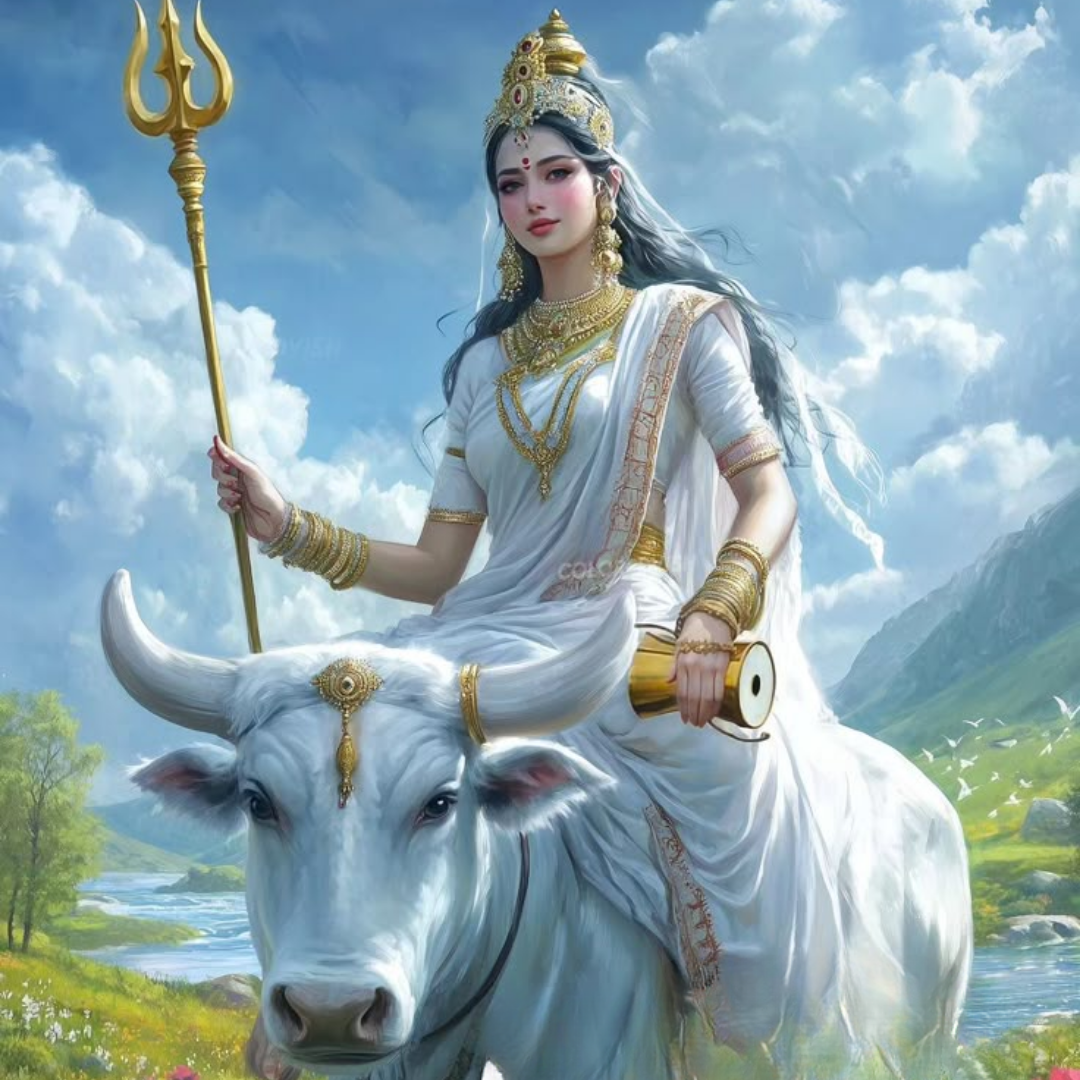
Conclusion: Embracing the Spirit of Navratri
As the 8th day of Navratri unfolds, it encapsulates the essence of devotion and cultural richness. This day signifies not just individual faith, but collective harmony and shared joy. Each ritual and gathering during Navratri enhances our connection to tradition and spirituality.
Throughout the Navratri festival, the worship of Goddess Durga in her various forms reminds us of the power and grace of feminine divinity. Each day’s significance blends to create a grand narrative of devotion. This celebration is a testament to the enduring allure of Indian festivals.
Navratri’s vibrant energy, marked by music, dance, and communal engagements, infuses life with enthusiasm. The festivities transcend mere observances, serving as a reminder of life’s profound wonders. They carry lessons of unity, resilience, and inner peace, which resonate beyond religious boundaries.
By participating in these rituals and practices, devotees from all backgrounds experience deeper connections. Navratri’s inclusive nature invites everyone to join, embrace, and understand shared human values. Its celebrations inspire new generations to cherish and continue these timeless traditions.
As the festival approaches its final days, it leaves a lasting impact. This sacred observance becomes a source of inspiration, encouraging a meaningful and reflective journey. Navratri’s joyous manifestations remind us of the enduring significance of cultural traditions.
Reflecting on the Festival’s Universal Appeal
Navratri transcends cultural and geographical boundaries, captivating hearts worldwide. Its universal themes of good over evil and light over darkness resonate deeply. Such themes appeal across cultures, inviting participation irrespective of personal beliefs.
The festival’s communal aspects foster a sense of global togetherness. Navratri unites communities, encouraging mutual respect and understanding. This unity underscores a shared human connection, emphasizing the common values of love, peace, and harmony.
In this inclusive spirit, Navratri teaches the virtues of empathy and compassion. It inspires hope and renewal, fostering meaningful bonds. The festival’s universal appeal lies in its powerful message of unity through diversity.
The Future of Navratri Celebrations
As we look ahead, the future of Navratri celebrations promises growth and innovation. With increasing global awareness, the festival is reaching new audiences. Technological advances and social media expand Navratri’s reach and influence.
Modern Navratri celebrations incorporate cultural exchange and adaptation. They balance traditional rituals with contemporary expressions, ensuring relevance in modern times. This dynamic evolution enriches Navratri, keeping its spirit alive and vibrant.
The festival will continue to be a beacon of cultural continuity and innovation. Future celebrations will reflect an enduring commitment to harmony and shared joy. Navratri stands as a celebration not only of tradition but of progress, welcoming a brighter future.
Frequently Asked Questions(FAQs)
1. What is the significance of the 8th day of Navratri?
The 8th day of Navratri is dedicated to Maa Mahagauri, symbolizing purity, strength, and spiritual growth. Devotees seek her blessings for peace and prosperity.
2. How do we worship Maa Mahagauri on the 8th day of Navratri?
On the 8th day, devotees offer white clothes, fruits, and sweets to Maa Mahagauri, chanting mantras and performing prayers to invoke her blessings for purity and health.
3. What is the meaning of Maa Mahagauri?
Maa Mahagauri is considered the Goddess of purity and is believed to bring strength, calmness, and positivity to her devotees. She is the eighth manifestation of Goddess Durga.
4. Why is Maa Mahagauri worshipped on the 8th day of Navratri?
Maa Mahagauri represents grace, wisdom, and purity. Worshipping her on the 8th day helps devotees purify their mind, body, and soul, and seek divine protection.
5. What are the benefits of praying to Maa Mahagauri on the 8th day of Navratri?
Praying to Maa Mahagauri on the 8th day is believed to bring spiritual upliftment, mental peace, prosperity, and protection from negative energies.
6. Can I fast on the 8th day of Navratri for Maa Mahagauri?
Yes, many devotees observe a fast on the 8th day of Navratri as a way to show devotion to Maa Mahagauri, purifying both the body and the mind.
7. What are the rituals for the 8th day of Navratri?
The rituals include chanting of Maa Mahagauri’s mantras, offering white flowers, performing aarti, and seeking her blessings for peace, health, and prosperity.


